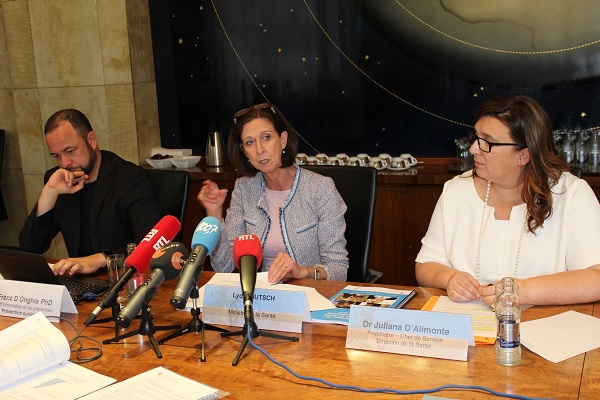
Health Minister Lydia Mutsch today introduced the National Plan for the Prevention of Suicide in Luxembourg (PNPSL) for 2015-2019, and presented the priority actions and statistics for the Grand Duchy.
The PNPSL has been developed in close collaboration with the Centre for Information and Prevention, and aims to tackle the causes and consequences of suicide, thereby reducing suicide attempts and deaths in Luxembourg. The PNPSL was originally based on the Australian model 'Living is for Everyone' (LIFE), whose basis in scientific evidence as a driving force for the development of a suicide action plan has seen it applied in several different countries including Australia, New Zealand and Scotland. The main purpose of the model focuses on strengthening individuals, families and the community in order to increase the latter's capacity to rapidly respond to a person's plight.
Between 2000 and 2013, the number of suicides in Luxembourg was estimated at 1,017, with 2014 alone accounting for 85 of the probable cases. With a standardised suicide rate of 8.7 per 100,000 in 2012, the Grand Duchy ranks below the European average. The number of suicides in the European Union 28 rose to 61,929 in 2012, representing a suicide mortality rate of 12 per 100,000.
"The Government has been working on the subject since 2006, but the country still did not have a plan," explained Health Minister Lydia Mutsch. "This involves breaking a taboo, as well as in the case of talking about it in schools, because younger people are also affected by it. Suicide even represents one of the leading causes of death among young people aged between 25 and 29."
Epidemiological data collected on suicide in Luxembourg has revealed that nearly one in 50 deaths is suicide. Suicide was also found to affect men more than women, with the sex ratio of men to women standing at 3 : 1, or 66 men to 19 women in 2014. The magnitude of the problem becomes even more visible with the revelation that the figure for attempted suicides is ten to twenty times greater than the suicide mortality rate.
The World Health Organisation (WHO) discovered that for every suicide, at least six people of the deceased's entourage experience a grave psychological, social and/or financial impact. The Ministry of Health therefore stated that despite the complex interactions between various risk factors that ultimately culminate in suicide, it is preventable and the means to significantly reduce the number of suicidal deaths do exist.
Dr. Fränz D'Onghia of the Centre for Information and Prevention emphasised this point, insisting: "Everyone has an important role to play in suicide prevention, starting with health structures, schools, but also the corporate world and the community at large. It is by working together that we will manage to save lives."
The fight for suicide prevention will depend on a multisectoral ('Health in all Policies') approach to address the risk factors at different levels, by covering the education of children and young people, continued researching of effective treatments for mental illnesses, environmental responses to and analysis of risk factors.
"To be effective, suicide prevention must be part of a comprehensive and continuous approach," stated Dr. Juliana D'Alimonte of the Directorate of Health.
The priorities of the action plan will include a focus on general prevention, at-risk youth populations, the elderly, a further decentralisation of support structures, specific training and therapeutic support. The first 2015-2019 action plan is reportedly comprised of around 33 priority actions which have been developed by experts in the field and approved by the Interdepartmental Group for Suicide Prevention.
An external evaluation of the action plan will also be carried out in order to assess the efficacy of the prevention strategies and the success of the overall project.
Photo by Ministry of Health (L-R: Dr. Fränz D'Onghia of the Centre for Information and Prevention ; Health Minister Lydia Mutsch ; Dr. Juliana D'Alimonte of the Directorate of Health)








